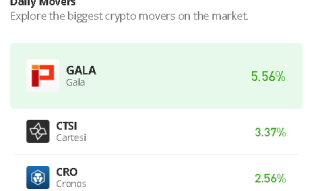Join Our Telegram channel to stay up to date on breaking news coverage
Financial companies like Deloitte, S&P Global, and Moody’s have teamed up to support the Canton Network’s launch, a blockchain that uses Web3 technology to simplify financial markets.
According to the press release, the network intends to give businesses decentralized infrastructure that might boost transaction efficiency by connecting financial systems and enabling them to run in unison.
They are stating that, using this new blockchain,
Assets, data, and cash can synchronize freely across applications. This gives financial institutions the chance to provide their customers with novel, cutting-edge solutions while also improving their effectiveness and risk management.
Despite a decline in the value of digital assets last year, institutional adoption of Web3 technology remained strong. The announcement shows that, despite regulatory uncertainty in the United States and damage from a number of crypto-native collapses, some businesses continue to be optimistic about the promise of blockchain technology.
The software firm Digital Asset developed the smart-contract language Daml, which is used by the Canton Network.
In the press release it is explained that due to three significant shortcomings, smart contract blockchain networks have not yet been widely used by financial institutions and other businesses. These shortcomings are said to be:
- Data control and privacy issues: Other chains have issues with privacy that preclude several regulated players on the same network from using the technology.
At every layer of its network, no other blockchain can currently provide data protection or control. - Other blockchains have been forced to compromise between control and interoperability: in order to achieve interoperability, other chains need operators to give up full control over applications by using a shared pool of validators.
- The inability to scale: It is difficult to achieve the scale and performance that financial institutions require because apps compete for global network resources and because public blockchains have intrinsic capacity restrictions.
According to Yuval Rooz, co-founder and CEO of Digital Asset,
For the first time, financial institutions may achieve the full benefits of a global blockchain network while working inside the regulatory guardrails that assure a secure, sound, and fair financial system. This represents a big advance for the blockchain industry.
There are already 30 partners in the Canton Network, including Paxos, Goldman Sachs, BNP Paribas, Cboe Global Markets, and Microsoft. According to the group, when more applications are built this year, the network’s connections will increase dramatically.
According to the announcement, the network is built to fully address these most frequent barriers preventing institutions from adopting Web3 technology, mentioned above, namely the lack of privacy and control over data, trade-offs with chains that already provide interoperability, and scaling issues. And starting in July, users on the network will start evaluating how well it works with various use cases and applications.
A much improved technology
These titans of the financial sector give Canton’s promises that it will alter how financial markets operate some credence. The group provided the example of how asset registers, which house asset information, and cash payment systems, which are used to make payments, are currently segregated and separate.
According to Canton, it is possible to integrate a digital bond and a digital payment into a single transaction, ensuring that they occur simultaneously and without any problems. By connecting it to various applications, a digital asset can also be utilized in other financial activities, such as collateralizing a loan.
The tokenization of assets—the representation of assets like stocks with digital tokens—could be a turning point for traditional finance, according to BlackRock CEO Larry Fink, as it has the potential for “instantaneous settlement” and “reduced fees.”
And a few Canton Network participants, like Cathy Clay of Cboe Global Markets, appear to concur.
“At Cboe, we believe the tokenization of real-world assets may offer an unprecedented opportunity,” said Clay, executive vice president of data and access solutions, in a prepared statement. He also added that it could “create new market infrastructure and drive efficiency in the trading of products across the globe.”
Canton Network: What Does it Bring to the Table?
Since DAML applications currently allow interoperability, a more detailed description of the Canton Network is useful.
Applications created using DAML 2 leverage the Canton blockchain, in contrast to prior versions of DAML which did not. A network of Canton blockchains makes up this new network of networks.
The support that DAML provides for various blockchain technology is well recognized. Applications can therefore use different enterprise blockchains if they want to improve some of the trust features, but Canton is where the bulk of the data is kept. Additionally, although it takes some effort, Canton blockchains can currently communicate with one another.
The Canton Network’s goal is to establish an open, interoperable third-party zone that is impartial and easy to connect. The barrier to interoperability is lowered.
The Corda Network was introduced by R3 for dApps using its DLT years ago, thus the idea is not brand-new, but the methodology differs.
Blockchains want to accomplish two important things. When trading is involved, time-stamping the order of transactions is crucial. The other is making sure that transactions are legitimate. The Canton Network focuses on time-stamping or sequencing, which helps to maintain privacy and improve scalability, as opposed to the Corda Network, which targets both.
An analogy is the postal service, in which each person has a mailbox and a sorting facility. A separate sorting plant is operated by each Canton application. A shared sorting facility for connected transactions can be run by applications that desire to connect to one another.
These applications can leverage the Canton Network, which offers a decentralized sorting facility infrastructure, an autonomous manner of organizing transactions, rather than building a shared sorting facility. But because it is not a validator, it does not see how the information contained in transactions contributes to maintaining privacy. Transactions are instead forwarded to the destination app, which verifies whether they make sense or not.
Scalability is improved because shared validators are not present. Applications may have a second network to scale if their workflows are separate.
There are many methods for achieving blockchain interoperability, none of which have attracted much attention to yet, and each of which has advantages and disadvantages. Thus, the timing of the Canton Network seems to be right.
Related
- Deloitte Integrates Blockchain for Secure and Transparent Digital Credentials
- The Sandbox Teams Up With Ledger Enterprise To Secure Brands In The Metaverse
- Best Crypto Presales
Best Wallet - Diversify Your Crypto Portfolio
- Easy to Use, Feature-Driven Crypto Wallet
- Get Early Access to Upcoming Token ICOs
- Multi-Chain, Multi-Wallet, Non-Custodial
- Now On App Store, Google Play
- Stake To Earn Native Token $BEST
- 250,000+ Monthly Active Users
Join Our Telegram channel to stay up to date on breaking news coverage


